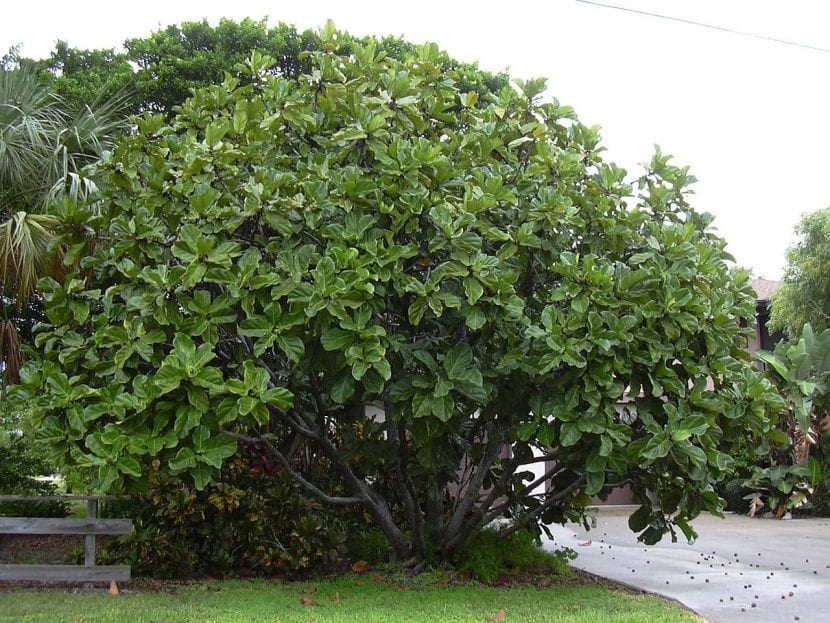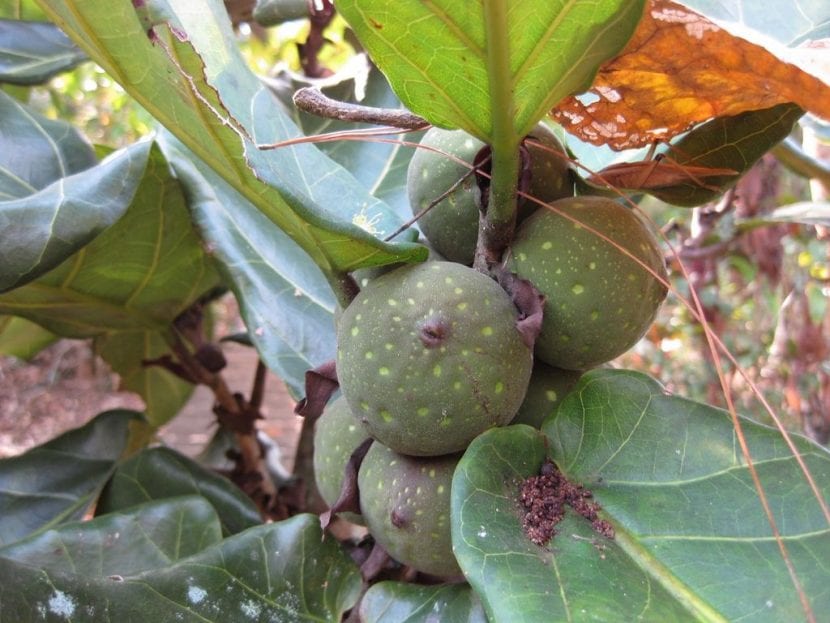
El ficus lyrata It is a very fast growing tree that can be had both in medium tropical gardens and in pots. It is very adaptable and very easy to care for, so you will be able to enjoy it from day one.
If you want to know everything about this curious and beautiful plant, then I'm going to explain everything about her.
Origin and characteristics of ficus lyrata

Our protagonist is a tree native to West Africa, from Cameroon to western Sierra Leone whose scientific name is ficus lyrata and that receives the common names of Ficus lira, Tree lyre, Ficus lirado and Fig tree with violin leaves. She begins her life as an epiphyte, germinating on the branch of a tree that is gradually strangled by its roots. When the host tree dies, it rots, leaving only the Ficus lira. Reaches a height of 12-15 meters, and normally has a parasol crown composed of large leaves 20-25cm long in the shape of a lyre or violin. The fruit is a green fig that measures 2,5 to 3cm in diameter.
Its growth rate is quite fast, but better let's see it in more detail so that nothing escapes us. 🙂
How do you take care of yourself?
If you want to have a copy, we recommend that you provide it with the following care:
Location
Ficus lyrata is a plant that can be in full sun or in semi-shade. However, if it is grown indoors we must place it in a room where a lot of natural light enters.
Earth

Image - Gramoflor.com
- Flower pot: Universal culture substrate mixed with 30% perlite can be used.
- Garden: the soil must have good drainage and be rich in organic matter.
Irrigation
It has to be frequent, especially in summer. Ideally, water every 2-3 days during the hottest season, and once a week the rest of the year.
Subscriber
From the beginning of spring to the end of summer it is very important to fertilize it with universal liquid plant fertilizer. following the indications specified on the product packaging. In the case of having it in the garden, we can also use organic fertilizers, such as manure, guano, stale vegetables (that can no longer be eaten), tea bags, or compost.
Planting or transplanting time
In spring, when the risk of frost has passed. In case of having it in a pot, it will have to be transplanted every two years.
Multiplication

Seeds
Ficus lyrata is a plant that multiplies by seeds in spring, following this step by step:
- The first thing to do is fill a pot or other seedbed with universal growing substrate
- Afterwards, we place the seeds on the surface and cover them with a thin layer of substrate.
- Finally, we water and place near a heat source.
The first will germinate in 15-30 days.
Cuttings
A faster way to get a new copy of ficus lyrata is multiplying it by cuttings in spring, following this step by step:
- First, a branch of about 40cm is cut and the base is impregnated with rooting hormones in powder or with homemade rooting agents.
- Then plant it in a pot with vermiculite or plant substrate.
- Then it is watered.
- Finally, it is placed in an area protected from direct sun.
If everything has gone well, in a month, maximum two, it will begin to emit roots.
Plagues and diseases
It's very tough. Could have some cochineal if the environment is dry and very warm, but nothing serious. In addition, it could be easily removed with a cotton swab moistened with pharmacy alcohol and removed by hand.
Pruning
If the branches grow too big can be pruned in late winter / early spring. It is also necessary to remove those that are dry, sick or weak so that it can continue to look beautiful.
Rusticity
It is a very sensitive plant to frost. It can withstand up to -1ºC provided it is an adult and acclimatized tree, but the ideal is that the thermometer does not drop below 10ºC.
Can it be grown in a pot?

Yes of course. In fact, it is one of the most loved indoor plants. Despite the adult size it can reach, its growth can be easily controlled by pruning. The only thing we have to keep in mind is that it must be in a room with a lot of natural light, away from drafts (both cold and warm) and that, every time we water, we have to remember to remove the water from the dish that has been left over ten minutes after watering.
Likewise, it is highly advisable to pay it with liquid fertilizers from spring to summer so that it can grow well and do not lack anything. In this way, our Ficus lira will be healthy.
What did you think of this plant? Did you know her? If you dare to buy it, visit a nursery or garden store in your area: surely you will find it there easily. Enjoy it.
I brought some seeds from Paraguay and planted them in April and covered the pot with a nylon so that the soil does not dry out or cool down and until today it has not sprouted. I must wait until spring.